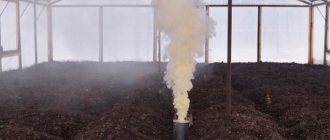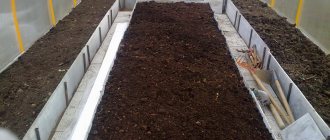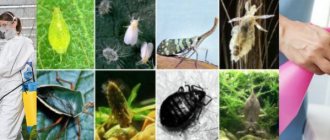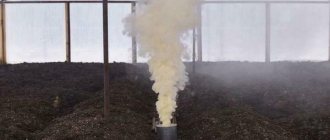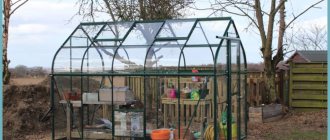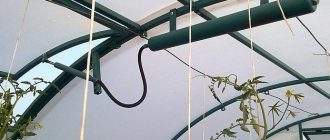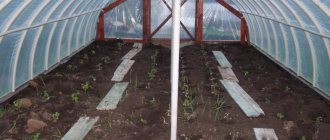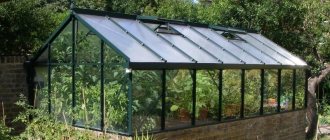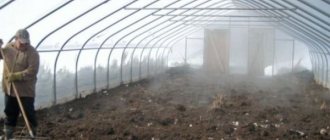A greenhouse is a garden building familiar to our country. In most regions, it is the only place where it is possible to grow heat-loving crops, as well as early sowing of seeds for seedlings.
A greenhouse is a separate microcosm where, during the growing season, the processes of germination, hardening, plant maturation and crop ripening occur. The intensity of use of this separate area is very high - plantings are organized alternately, densely, soil exploitation is constant from April to September. Under these conditions, there is a high probability of rapid depletion of the land and its colonization by pathogenic microorganisms. Therefore, gardeners have to take measures to eliminate and prevent plant diseases in the greenhouse. To do this, you need to disinfect the soil in the greenhouse.
Disinfection of soil in a greenhouse
Methods for cultivating soil in a greenhouse
There are several ways leading to achieving a healthy substrate, and therefore obtaining strong and safe plants for consumption:
- agrotechnical - using agricultural methods of working with arable land;
- biological - with the creation of natural well-being of the soil;
- chemical - using industrially created substances that eliminate diseases.
Each of these methods has advantages and disadvantages. But their use improves the condition of the soil in the greenhouse, increases productivity and guarantees the safety of using grown products.
To ensure good conditions for plants, very careful preparation of the soil for the greenhouse is necessary.
Agricultural technology
The basis of agriculture, whether in a greenhouse or open ground, is crop rotation. Pests accumulate where crops of the same family are grown year after year. This also contributes to the creation of conditions for the flourishing of soil microorganisms (fungi), since the conditions necessary for the same plants persist for several years.
Important! A completely different matter is a change of cultures. If you plant different plants in a greenhouse every year (at least every 1-2 years), then the incidence of diseases in the soil and crops will noticeably decrease.
Crop rotation
For example, cucumbers love high humidity and temperature. The soil under them should not dry out. In such conditions, the mushroom mycelium develops well, and in a year or two it will be problematic to cope with it. And if next year you plant tomatoes in this greenhouse, then you will have to create completely different conditions for them: dry air, temperatures much lower than for cucumbers, frequent ventilation. This will not allow the development of either fungi or some soil microbes.
Conditions for growing tomatoes and cucumbers in a greenhouse
Important! From an agronomic point of view, it is better to build 2-4 small greenhouses on a site than one giant one. This will help increase productivity, and in itself the creation of individual conditions for each plant with the application of fertilizers according to needs is another excellent technique.
Dependence of the location of the greenhouse on the shade of shrubs
Another way to improve soil health is to reduce soil acidity. For the most part, our soils are highly acidic, which in itself is not bad - microbes do not live in acidic soil. But there are few nutrients in it, beneficial microorganisms also do not take root, which means that plants grow either weakened or overfed with fertilizers. Neither one nor the other contributes to prosperity, so the plants die, leaving an environment for the development of rot, which significantly worsens the composition of the substrate and increases the incidence of crop diseases.
Store-bought kit for testing soil acidity
Soil acidity scale
Acidophiles - plants of acidic soils
Basiphyla - plants of alkaline soils
Neutrophils – plants of neutral soils
The addition of long-acting natural supplements in reasonable quantities will help reduce acidity and thereby correct the situation with natural fertility, such as:
- chalk;
- dolomite flour;
- ash.
These natural fertilizers are applied in the spring, after the melt water has disappeared, and repeated no earlier than after 2 years.
Required soil acidity for various crops
Limestone (dolomite) flour
Prices for dolomite flour
dolomite flour
Thermal method
It involves pouring hot water onto the greenhouse soil.
- It is advisable to dig it up first for deeper penetration of boiling water.
- Usually they are shed at least 3 times, after which the entire watered surface is covered with film to maintain the elevated temperature for a longer period of time.
The method is simple, but it is difficult to determine whether it brings more benefit or harm. Indeed, under the influence of high temperatures, the beneficial microflora is almost completely destroyed. I think this technique is more appropriate for small areas.
Biology to the rescue
To disinfect the soil, it is advisable to use natural healing methods. This means that only natural factors should be used, without adding artificially created chemicals.
Means that reduce the number of pathogens in the substrate include, first of all, thermal ones, including:
- steaming the soil is a rarely used technique for greenhouses due to its labor intensity; the top layer of the bed is removed and placed in a container permeable to steam and fixed over a vessel with boiling water for half an hour to an hour, which is how to eliminate microbes;
Thermal treatment of soil
- freezing of the soil - in most cases occurs naturally in areas with low winter temperatures - if the greenhouse is not dismantled for the winter, the soil freezes stronger than in open ground due to the absence of a snow “blanket”, which helps destroy microbes and fungi.
Thermal methods destroy not only harmful microorganisms, but also those that make the earth alive, so subsequent enrichment activities are required.
Such actions include another method of soil disinfection - the colonization of beneficial flora and fauna, i.e., the introduction of preparations containing colonies of the necessary bacteria. These products include all varieties of drugs “Baikal”, “Baktofit”, “Trichodermin”, etc. All of them naturally suppress the pathogenic microcosm of the soil and at the same time enrich it.
Baikal EM 1
Baktofit - biological fungicide and bactericide
The most effective way to biologically restore the soil is considered to be a timely change of soil. At the same time, they replace the soil in the greenhouse not with a substrate purchased in a store, but with a home-made composition - compost.
Replacing soil in a greenhouse
It is known that during the process of rotting, plant residues mixed with old soil (taken out of the greenhouse), as well as manure and purposefully applied fertilizers or soil enrichers, undergo many processes during the composting process (fermentation, rotting, processing by bacteria and worms, mixing, heating, hydration and many others). All this results in better soil composition - high quality soil, free of pathogens and rich in nutrients. Therefore, a compost heap (pit, stack) must be built in every garden plot.
Compost heap organization diagram
Important! The owner of a personal plot must know how to create ideal soil using composting.
Example of a compost heap
Use of formaldehyde
Due to the toxicity of the drug itself and the toxicity of its vapors, formalin is rarely used to disinfect beds. However, if the soil in the greenhouse is contaminated with mold fungi and whitefly larvae, it is sometimes treated with a formaldehyde solution prepared from five buckets of water and one liter of the drug at a standard 40% concentration.
If mold appears on the ground, it can be treated with formaldehyde
Attention! Spilling the beds with formaldehyde is carried out in an industrial respirator. No more than one and a half buckets of working solution are added per square meter, after which the greenhouse is closed for 3 days, then it is ventilated for two weeks, and then the beds themselves are dug deep.
Chemical remedies
In some cases, for example, during the initial construction of a vegetable garden and greenhouse (if the soil on the site is obviously contaminated), the use of “heavy artillery” is required - chemicals to combat pathogens. Naturally, these means will destroy all life inside the soil and create dead soil. But it is quite possible to populate it with the necessary bacteria, so sometimes it is worth resorting to this method of protection.
The ground is watered with a disinfectant solution
Today there are a lot of drugs that help fight soil diseases. Most of them are biological agents. Absolutely chemical products require caution when preparing mixtures and carrying out work.
How to treat greenhouse soil
Table. Some characteristics of common chemicals.
| A drug | Method of influence | Preparation | Application time | Peculiarities |
| Bleaching powder | Adding powder to the soil | 200-300 mg per 1 m² | In autumn after harvest | Strictly observe the timing of application (six months before planting) - many plants do not tolerate chlorine well |
| Formalin | Watering the soil with a solution | A 40% solution is diluted in 10 liters of water - this is for watering 1 m² | In autumn or spring, no later than 2 weeks before planting | Used instead of bleach; Long-term ventilation is required after use - while maintaining vapors in the soil and air, it is phytotoxic |
| Copper preparations (Bordeaux mixture, copper sulfate) | Watering the topsoil | 2-3% solution | In autumn, and before sowing - only local copper-containing preparations (into the hole) | Apply no more than once every 5 years - accumulates in the soil and becomes toxic to plants and people |
| Sulfur preparations | Gas exposure when ignited or mixed with slaked lime in powder form | The sulfur bomb is set on fire and left in a tightly closed room; the mixture is spread over the surface and harrowed | In autumn, (less often in spring) | Ventilation is necessary after burning sulfur, especially in spring. |
| Fungicide TMTD | Scattered on the soil, harrowed | 50-80 g per 1 m², watering with a 0.5% solution of potassium permanganate is required - 6-12 l per 1 m² | Anytime, non-phytotoxic | Low efficiency, additional application of boron preparations is required |
| Iprodione 2% | Powder into the soil | Per hole 40-60 g, per soil 100-150 per 1 m² | For spring digging or when planting | Do not exceed dosage |
Important! When working with soil treatment chemicals, you must take precautions: wear gloves, a robe, goggles and a mask. Do not smoke, drink or eat while working. At the end of the procedure, remove protective clothing and ventilate outside, wash your hands and face with soap, rinse your mouth and nose.
Gas and smoke protection kit-GDZK-A
Prices for potassium permanganate
potassium permanganate
How to clean a greenhouse in spring, inside and out
Cleanliness is the key to health. This statement is as true for plants as it is for people. If the greenhouse was washed in the fall, then in the spring there will be much less hassle. All that remains is to update the result: go over all the details of the coating with clean water using a regular rag. You can also use an electric sprayer charged with clean water or a washing system, if available.
Polycarbonate requires tenderness! Washing a greenhouse made of cellular polycarbonate should be done carefully, using microfiber cloths or soft sponges. This will prevent scratches and cracks. The water pressure in the washing station when using it should be minimal.
How to wash a greenhouse in the spring if it has been dirty for the winter? Ordinary soapy water is best suited for these purposes (it is better to use laundry soap or special garden soap). You can add a drug to the water against a particularly annoying disease or pest from last season, if there were any.
First, you can go through the greenhouse inside, then outside, leaving the foam on the surfaces for at least 10 minutes. Just when you've finished washing the outside, it's time to go back inside. In the same sequence, rinse all surfaces clean. When washing inside, you should be careful so that the soap solution does not fall on the ground.
Advice! Before you start wet cleaning, dry clean to remove dust and dirt. Then washing will be faster and easier.
How to wash a greenhouse with a washing station
Planting material
It is very important to plant healthy seedlings in the greenhouse or sow seeds that are not infected with diseases. Even the best soil, capable of resisting pathogens, can suddenly contain so many pathogens that it cannot cope. Therefore, you should not test the disinfecting properties of soil.
To treat the seeds, it is enough to soak them in a weak solution of potassium permanganate or a soap suspension (the soap should be laundry soap). Then the seed should be rinsed and dried. It is recommended to sow seeds for seedlings in a high-quality mixture.
Soak the seeds in potassium permanganate to disinfect
Important! Contrary to popular belief, most soil mixtures offered by specialty stores are safe from the point of view of contamination by harmful microbes and eggs of pests.
You can make planting mixtures yourself by preparing leaf, turf, coniferous soil and sand in advance. All ingredients of the future substrate are well frozen in winter. If you have doubts about the quality, you can heat small amounts of soil in the oven.
Land for seedlings
Thus, creating a healthy microclimate in a greenhouse and growing strong and healthy plants is quite possible.
The conditions necessary for this will be created by:
How to treat a greenhouse against spider mites in the fall
Spider mites are a very dangerous, voracious pest that can easily destroy all your plants and ruin your harvest, as it spreads very quickly throughout the greenhouse. Read more about how to deal with it here.
Healthy soil and the same plants on it successfully resist the moderate onslaught of pathogens that are constantly present in the atmosphere and earth. Therefore, there is no need to worry about the harvest.
Basic disinfection techniques
The destruction of pathogenic bacteria, viruses, fungi, protozoa and helminth eggs is a very pressing issue, the solution of which is given a lot of time and effort. Today, several multidirectional measures are known that allow you to get rid of not only vegetative forms, but also bacterial spores:
- Biological techniques.
- Physical or agricultural means.
- Insecticides.
Sometimes traditional methods are also used, for example, mustard seeds. After using any of the known drugs, you will need to start restoring normal flora in fertile soil.
For this purpose, you can purchase complexes of soil bacteria, which are added together with potassium compounds. Particular attention is paid to soil treatment with insecticidal preparations that are toxic to humans and animals.
Such drugs can accumulate in fruits and cause acute poisoning when consumed. To prevent these conditions, plants that act as indicators (some varieties of lettuce) should be planted in greenhouse beds.
